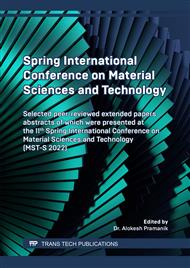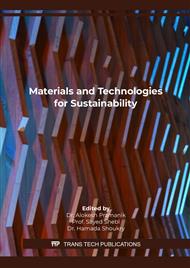[1]
W.S. Miller, L. Zhuang, J. Bottema, et al. Recent development in aluminium alloys for the automotive industry, Mater. Sci. Eng. A 280 (2000) 37-49.
Google Scholar
[2]
J. Hirsch, Recent development in aluminium for automotive applications, Trans. Nonferrous Met. Soc. China 24 (2014) 1995-2002.
Google Scholar
[3]
Z. Yang, X. Jiang, X. Zhang, et al. Natural ageing clustering under different quenching conditions in an Al-Mg-Si alloy, Scr. Mater. 190 (2020) 179-182.
DOI: 10.1016/j.scriptamat.2020.08.046
Google Scholar
[4]
L. Lin, Z. Liu, B. Song, et al. Effects of germanium on quench sensitivity in Al-Zn-Mg-Zr alloy, Mater. Des. 86 (2015) 679-685.
DOI: 10.1016/j.matdes.2015.07.169
Google Scholar
[5]
J.S. Chen, X.W. Li, B.Q. Xiong, et al. Quench sensitivity of novel Al-Zn-Mg-Cu alloys containing different Cu contents, Rare Met. 39 (2020) 1395-1401.
DOI: 10.1007/s12598-017-0981-y
Google Scholar
[6]
S. Liu, X. Wang, Q. Pan, et al. Investigation of microstructure evolution and quench sensitivity of Al-Mg-Si-Mn-Cr alloy during isothermal treatment, J. Alloys Compd. 826 (2020) 154144.
DOI: 10.1016/j.jallcom.2020.154144
Google Scholar
[7]
B.C. Shang, Z.M. Yin, G. Wang, et al. Investigation of quench sensitivity and transformation kinetics during isothermal treatment in 6082 aluminum alloy, Mater. Des. 32 (2011) 3818-3822.
DOI: 10.1016/j.matdes.2011.03.016
Google Scholar
[8]
G.P. Dolan, J.S. Robinson. Residual stress reduction in 7175-T73, 6061-T6 and 2017A-T4 aluminium alloys using quench factor analysis, J. Mater. Process Tech. 153-154 (2004) 346-351.
DOI: 10.1016/j.jmatprotec.2004.04.065
Google Scholar
[9]
G. Gao, C. He, Y. Li, Influence of different solution methods on microstructure, precipitation behavior and mechanical properties of Al-Mg-Si alloy, Trans. Nonferrous Met. Soc. China 28 (2018) 839-847.
DOI: 10.1016/s1003-6326(18)64717-x
Google Scholar
[10]
G.H. Tao, C.H. Liu, J.H. Chen, et al. The influence of Mg/Si ratio on the negative natural aging effect in Al-Mg-Si-Cu alloys, Mater. Sci. Eng. A 642 (2015) 241-248.
DOI: 10.1016/j.msea.2015.06.090
Google Scholar
[11]
A.V. Mikhaylovskaya, A.A. Kishchik, A.D. Kotov, et al. Precipitation behavior and high strain rate superplasticity in a novel fine-grained aluminum based alloy, Mater. Sci. Eng. A 760 (2019) 37-46.
DOI: 10.1016/j.msea.2019.05.099
Google Scholar
[12]
A. Serizawa, S. Hirosawa, T. Sato, Three-dimensional atom probe characterization of nanoclusters responsible for multistep aging behavior of an Al-Mg-Si alloy, Metall. Mater. Trans. A 39 (2008) 243-251.
DOI: 10.1007/s11661-007-9438-5
Google Scholar
[13]
H.W. Zandbergen, S.J. Andersen, J. Jansen, Structure determination of Mg5Si6 particles in Al by dynamic electron diffraction studies, Science 277 (1997) 1221-1225.
DOI: 10.1126/science.277.5330.1221
Google Scholar
[14]
G. Gao, Y. Li, Z. Wang, et al. Study of retrogression response in naturally and multi-step aged Al-Mg-Si automotive sheets, J. Alloys Compd. 753 (2018) 457-464.
DOI: 10.1016/j.jallcom.2018.04.198
Google Scholar
[15]
P.H. Ninive, A. Strandlie, S. Gulbrandsen-Dahl, et al. Detailed atomistic insight into the β" phase in Al-Mg-Si alloys, Acta Mater. 69 (2014) 126-134.
DOI: 10.1016/j.actamat.2014.01.052
Google Scholar
[16]
S. Zhu, Z.H. Li, L.Z. Yan, et al. Transformation behavior of precipitates during artificial aging at 170°C in Al-Mg-Si-Cu alloys with and without Zn addition, Rare Met. 40 (2020) 1907-1914.
DOI: 10.1007/s12598-020-01427-z
Google Scholar
[17]
Y.X. Lai, B.C. Jiang, C.H. Liu, et al. Low-alloy-correlated reversal of the precipitation sequence in Al-Mg-Si alloys, J. Alloys Compd. 701 (2017) 94-98.
DOI: 10.1016/j.jallcom.2017.01.095
Google Scholar
[18]
S. Pogatscher, H. Antrekowitsch, H. Leitner, et al. Influence of the thermal route on the peak-aged microstructures in an Al-Mg-Si aluminum alloy, Scr. Mater. 68 (2013) 158-161.
DOI: 10.1016/j.scriptamat.2012.10.006
Google Scholar
[19]
R.K.W. Marceau, A. de Vaucorbeil, G. Sha, et al. Analysis of strengthening in AA6111 during the early stages of aging: Atom probe tomography and yield stress modelling, Acta Mater. 61 (2013) 7285-7303.
DOI: 10.1016/j.actamat.2013.08.033
Google Scholar
[20]
Y. Weng, L. Ding, Y. Xu, et al. Effect of In addition on the precipitation behavior and mechanical property for Al-Mg-Si alloys, J. Alloys Compd. 895 (2022) 162685.
DOI: 10.1016/j.jallcom.2021.162685
Google Scholar
[21]
P. Sepehrband, X. Wang, H. Jin, et al. Interactive microstructural phenomena during non-isothermal annealing of an Al-Mg-Si-Cu alloy, Mater. Charact. 137 (2018) 212-221.
DOI: 10.1016/j.matchar.2018.01.014
Google Scholar
[22]
L Gang, J Wang, Y Liu, et al. Effect of heating rate during solution treatment on the bendability of Al-Mg-Si alloys, Mater. Sci. Eng. A 791 (2020) 139604.
DOI: 10.1016/j.msea.2020.139604
Google Scholar
[23]
Z Fan, X Lei, L Wang, et al. Influence of quenching rate and aging on bendability of AA6016 sheet, Mater. Sci. Eng. A 730 (2018) 317-327.
DOI: 10.1016/j.msea.2018.05.108
Google Scholar
[24]
M Yang, H Chen, A Orekhov, et al. Quantified contribution of β" and β' precipitates to the strengthening of an aged Al-Mg-Si alloy, Mater. Sci. Eng. A 774 (2020) 138776.
DOI: 10.1016/j.msea.2019.138776
Google Scholar
[25]
Y. Kim, R.K. Mishra, A.K. Sachdev, et al. A combined experimental-analytical modeling study of the artificial aging response of Al-Mg-Si alloys, Mater. Sci. Eng. A 820 (2021) 141566.
DOI: 10.1016/j.msea.2021.141566
Google Scholar



